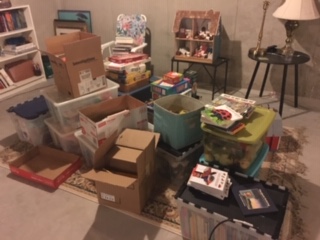
Decluttering for Empty-Nesters
Why is decluttering so difficult? It sounds easy. We moved twice to get rid of stuff. But there are still tears in what I call the next level of the declutter game. It changes over time as you change. Let me explain.
Some years back before the declutter trend of today I was fascinated by the idea of having less. People were just starting to write about it. One such geek bragged of “100 Things”. Actually, the awe and wonder from this young man’s point of view was that he had acquired 100 things. He hadn’t purged to get to 100. He was renting one room from a friend, confident he needed little, and enjoying his space more based on this confidence. A bit different than empty-nester’s dilema, but I appreciated his spirit.
Our purging began with the easy stuff and grew into downsizing
We decided to flip that trend to meet our needs and called it “Reduce by 100.” The next Saturday afternoon and several others we got boxes and began counting. It was an amazing feeling! This is why people are obsessed with decluttering. It feels nice to live with less. To have only what you need (or think you need). After a year of this thinking, we decided to sell the big house. Then the fun really began. We moved again a few years later. Both moves contributed to the process of reaching goals. Acknowledging that is key to success.
I am still surprised at the amount of stuff we have. How did that happen? We agreed to strict guidelines! I even tackled the books before the last move—but avoided one area entirely. Until now.
Our new house had a large unfinished basement. I was determined to know every item being stored and rank its contribution to sparking joy. And I do—with one elusive closed-box exception.
Know what you have, need, and more importantly, want—aka Goals
There are two overarching categories here. One being the used, but not used regularly category. Of that is sub categories like seasonal decor, china and crystal, tools, etc. We’ve reduced that quite a bit. We have decided to keep many items for entertaining. No shame.
The other category is a collection of items not used but hold deep attachment. It is the cherished toys, baby clothes, photo albums, and trinkets from our kids’ childhood. It is steeped with emotional connection and longing for that time gone by. (That time when I didn’t know the joys of empty nesting.) But there it is—a minefield of memorabilia.

Now some, like my son, would just store it to the rafters. He questions my efforts to purge. He is a collector, self-proclaimed. He loves to imagine an excavation decades from now uncovering a wonderful little bobble that brought him joy 30 years ago. “Why take away that possibility?” There is a part of me that sees his point. Another part remembers the depths of stuff left in our parents’ homes upon their death. I did not find joy there. You are moved to think about aging and your future when your parents die. This transition will help with the goal setting.
Our goals of old-age consist of living simply, likely abroad for short or long periods of time. That means that in the not-too-far-off future we will get a storage unit (something I loath doing), or ask the collector son to store our stuff. It is unlikely he will find joy in that. But that is why it is important to purge. It is part of our get-to-zero goals for the future. If it weren’t part of that goal I would enjoy and revel in my large basement storage.
How to deal with stuff at the advanced level
We agreed to move this memorabilia now but promised to go through it and reduce by half later. It was hard to find that loophole to our guidelines for moving stuff, but we did it. A year-and-a-half later, it started talking to us. I joked one day that it’s probably half our storage right now. Then, I wondered about quantification. I put down a large area rug. (Why am I storing this rug?) And placed all the offending material on it. Maybe not half of our storage, but definitely a third. It sat there for more than three weeks.
You must see it with different eyes. You must see it without the attachment and accept reducing by 10% or x%, you can decide. Bruce calls this removal of low-hanging fruit. I told him we were going to get into a large argument if he didn’t leave the basement now.
In the end, I did get rid of some tieras, miss-matched toys, half the nice puzzles, lots of stuffed animals, and toys that I don’t remember my daughter ever using (although they were like-new). I thanked each item, boxed them up, and donated in hopes that someone will find them and appreciate any joy left. That which I kept will be left for grandkids to discover or stacked in nice storage boxes that our adult children will surely discard in the future. That’s the best I can do for now. What I know for sure is that in a couple years, even these items will have less hold on me. That is the joy of decluttering over time.

